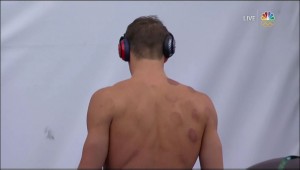Posts Tagged: injury rehabilitation
wrist and elbow qigong rehab
This is a qigong rehab exercise that I usually teach to clients with wrist or elbow problems. It is best done standing with feet about shoulder width apart and the knees bent, but it can also be done sitting. Relax the shoulders and draw your hands towards the chest with your palms facing you while breathing in and drawing the shoulder blades together gently. Then breathe out, let go of the shoulder blades, and extend the arms with the palms facing forwards and without forcing the movement, imagine pushing something heavy a long way away. Repeat as many times as you have time to do, 30 is a good number.
Michael Phelps’ cupping marks
Michael Phelps shows off his cupping marks. We Chinese medicine practitioners use cups to treat muscle tightness and pain, and pathogenic illness. It can be very effective alone, and can work even better when combined with acupuncture.
From our point of view the cups draw bad stuff out from deeper layers to the surface, whether it’s blood that has thickened because its flow has been restricted in a tight muscle, or external pathogenic factors that are associated with colds and flus. This explanatory model is common to traditional cupping practices throughout Asia, Europe, and Africa. A possible bio-medical explanation of how cupping helps with muscle tightness and pain is that it encourages phagocytosis to remove partially clotted blood. In his article “A Cupping Mark is not a Bruise”, cupping guru Bruce Bentley reports that a tissue sample taken from an athlete that had been cupped at the Australian Institute of Sport, was analysed as containing “old blood” (http://www.healthtraditions.com.au/uploads/212-cupping-proof.pdf).
I love doing cupping treatments. Not only do they work really well but they turn people into walking advertisements for Chinese Medicine. Not many of my patients expose their marks to as many people as Mr Phelps has though, nice one Michael.

